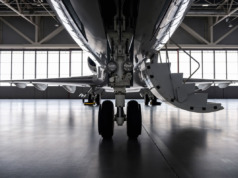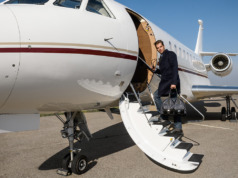Perhaps you’d like to offset some of the cost of your own flying by making your aircraft available for charter when you’re not using it. You have two ways to do so: you can secure your own FAA Part 135 charter certificate, or you can enroll your aircraft in a management program which holds such certification.
But maybe a friend – or a friend of a friend – asks to borrow your aircraft, and offers to pay you a fixed amount above the cost of fuel for that trip. Or, you’re approached by someone who offers to find you charter customers, guaranteeing you a fixed hourly fee.
He/she promises that you’ll avoid some of those “management fees” charged by charter operators, bringing you needed revenue, while keeping the cost of charter down for potential customers, always looking for lower prices.
That works. Right?
No, you’re not right – and you’re certainly not alone. A significant number of charter users and aircraft owners may be unaware that they are buying or selling “grey charter” or illegal trips.
While owner-only operated flying is governed by Federal Aviation Regulation (FAR) Part 91, the FAA, the DOT, and the IRS all have very specific rules governing any flight for which money changes hands. Such a flight is considered “commercial,” and must comply with their rules and regulations. Aircraft owners who violate those regulations are operating in the “grey charter” market, and putting the safety of their aircraft and passengers – and their company – at risk for penalties and tax liability.
The more stringent requirements and regulations of Part 135 are designed to protect the non-aviation-educated consumer.
There are two kinds of illegal charter. One happens when a charter broker or charter operator sells a trip aboard an aircraft that is not legally available for charter. The other is the borrowed or shared aircraft between friends, who fail to adhere to the very specific FARs governing aircraft time sharing.
So whether you seek to charter out your own aircraft, or to buy a charter trip when your aircraft is out for maintenance, or you temporarily need an extra or a different size aircraft, what do you need to know?
Ask – or be prepared to answer – these 15 questions, to help make sure that the charter trip you are about to accept or book is legal.
1 Is the aircraft available for charter according to the correct FAA regulations?
FARs require that an operator that provides “air transportation of persons or property for compensation or hire” possess a commercial operating certificate. Business aircraft available for hire are, in almost all cases, operated under FAR Part 135. Such operators are required to comply with FAA regulations in several areas including flight operations (e.g. limiting the length of crew duty days), maintenance, training, and insurance. Aircraft flown for owner use only, not for commercial use, have more freedom to set their own safety margins and are operated under the less stringent FAR Part 91. The more rigorous requirements and regulations of Part 135 are designed to protect the consumer: your charter customer, or you, when you’re flying aboard someone else’s aircraft.
2 Is the low price “too good to be true?”
The costs of compliance with the higher standards required under Part 135 must be included in the cost of the charter trip, in order for the charter management company to make a reasonable profit, and to provide a reasonable margin for you, the aircraft owner. Those operators not in compliance will not incur these necessary costs, and so may offer substantial discounts on charter flights – risking the charterer’s safety, and your potential revenue. With more than 35% of the U.S. jet and turboprop aircraft fleet, and a significant proportion of the total world’s fleet legally available for charter, you have a good pool of aircraft from which to draw. Why take a chance?
3 How well do you know your broker?
When you arrange a charter trip, seek out one of the many excellent, reputable charter brokers. These companies are led by experienced individuals with long histories of delivering safe and superior travel. Their websites proudly list senior managers’ names and credentials. Not so with a faceless app. (See “Beware the Invisible Broker,” BAA May/June 2016.) While there still are no federal or state regulations governing brokers, independent aviation auditors Argus and Wyvern now audit brokers.
4 Is the flight crew qualified?
Are they type rated for this aircraft? That is, are they specifically trained and tested in the exact make and model aircraft used for the charter? Is their training current? How often do they train/retrain, and where/with whom? Under Part 135, it is mandatory that pilots attend recurrent training every six months. What is their actual incident and accident history? And how many hours have they flown as Pilot-in-Command in this specific make/model aircraft? (See “5 Questions to Ask Before Chartering Your Next Jet,” BAA Jan/Feb 2018.)
5 Is the crew properly managed?
Are security background checks required for all flight and cabin crews, dispatchers, maintenance technicians, and anyone else who may have contact with your aircraft and flight arrangements? Is the entire crew regularly drug tested (mandated under Part 135, but not under Part 91)? Do pilots fly long duty days? Under Part 135, pilots can be on duty for up to 14 hours, of which they actually can be flying for 10 hours. Under Part 91, there are no restrictions.
6 Is the aircraft operated safely?
Does the flight operation adhere both to FAA regulations as well as the aircraft’s Original Equipment Manufacturer’s (OEM) flight manual specifications? Those might include: observing weight limitations, or limitations on runway performance, as well as local airfield regulations, such as noise and time curfews. Is there a Safety Management System (SMS) in place (See “Are You ‘Safe’?” BAA March/April 2017)? If the aircraft will be flying over water, does it carry a sufficient number of functioning life vests and life rafts? Is there a safety-trained flight attendant on board (See “Taking Attendants,” BAA July/Aug 2016)?
7 Is the aircraft maintained properly?
Is the aircraft current for all maintenance and inspections? Has the maintenance been performed in accordance with FAA regulations and OEM schedules? Part 135 aircraft are required to be maintained to the OEM’s standard, to ensure safety. Does the aircraft comply with all current equipment requirements? For example, by January 1, 2020, all aircraft must have appropriate equipment to bring them into compliance with the new ADS-B regulations. (See “Time Flies…Will Your Aircraft?” BAA, Jan/Feb 2018).
8 Is the aircraft correctly insured for charter trips?
Will your own insurance policy cover your aircraft in charter service? Most policies contain an exclusion clause for claims arising from a trip which did not comply with FAA regulations or other applicable laws.
9 Are you a “passenger” or an “operator”?
Some Part 91 operators may legally offer the use of their aircraft alone through means of a “dry lease.” The lessee then becomes the operator, with more attendant responsibilities, including hiring the crew, and ensuring that the aircraft operates in compliance with applicable regulations and OEM operating manuals. With a dry lease, when you are the lessor, you give up control of your asset, but still are responsible for all paperwork, and for filings with the FAA.
10 If using a charter broker, can he/she provide details on the specific aircraft and operator performing your flight?
Is your charter broker able and willing to provide the aircraft operator’s certificate number? Will your charter broker provide a copy of the operator’s DO85 aircraft specification (“spec”) sheet? This document lists every aircraft in the operator’s fleet that is approved for service by the FAA. A reputable broker will provide the tail number of your charter aircraft 24 hours in advance of your trip and it should be listed on the DO85. A few illegal operators have provided falsified documents to their unsuspecting customers. Information on your charter operator is available via the Flight Standards District Office (FSDO). Do your homework.
11 Are you charging, or being charged, correctly?
For that friend who wants to borrow your Part 91 aircraft, there is a legal – though stringent – means to do so. Under FAR Part 91.501, a time sharing arrangement, you are allowed to charge up to two times the cost of fuel consumed on the flight, as well as specific out-of-pocket expenses incurred for this particular flight (crew hotel, meals, etc.). When you are the passenger, take a close look at the receipts, and make sure you’re being billed correctly. At the end of June, the FAA alleged that a Michigan company violated several FAA regulations while chartering its aircraft for more than 850 flights. Among them was double-billing timeshare clients and failing to keep proper records. The company faces a $3.3 million civil penalty. Be certain that your charges are correct to avoid penalties.
12 Does the aircraft you charter comply with Part 135 record-keeping requirements?
Ask your properly certificated charter operator if their records and operations are regularly audited by one of three industry-accredited independent charter auditing firms (Argus, Wyvern, the Air Charter Safety Foundation), or by a recognized aviation consulting firm. Good recordkeeping provides evidence of proper maintenance and current crew training.
13 Do you understand the terms of your contract?
If you dry lease and have not stipulated otherwise, your passengers could be a hard-partying rock band. So long as you don’t violate the DOT’s anti-discrimination laws, you may specify who can fly aboard your aircraft; plus what substances or cargo you’ll allow, and where your aircraft can fly. When you’re the passenger, you have the right to add safety provisions: a third pilot for longer trips and/or a trained flight attendant.
14 Are the proper lease documents filed with the local FSDO?
While lease documents are required to be filed with the local FSDO, illegal operators may neglect to do so, making it less likely that the FAA will know about the trip. If the lease isn’t filed, it isn’t a legal lease, and both the aircraft owner and the passenger can be fined for violating FAR 91.23. With a dry lease, Federal “truth in leasing” regulations also apply.
15 Who owes the Federal Excise Tax for your trip?
It’s the charter purchaser – not the operator – who owes the tax. Whether you are the operator or the passenger, know that any flight that could be construed as having a profit motive – that is, more than just flight cost sharing, even if there’s an operating loss – must be reported to the IRS. Not doing so is a felony.
When you are the passenger, what can you do if you know or suspect the charter trip you are offered may not be lawful? In 2008, The National Air Transportation Association (NATA) established a hotline to report suspected illegal charter activity (1-888-759-3581). Currently administered by the Air Charter Safety Foundation (ACSF), the hotline can be used to report (anonymously if preferred) any operator without a Part 135 certificate who may be accepting compensation for transportation in violation of FAA and DOT regulations.
When you make your own aircraft available for charter, don’t take any chances. Asking these fifteen questions and doing your own due diligence will help keep you flying safely and legally. BAA
Above and Beyond: The BAA Podcast Series
Shedding More Light on Illegal Charter
Fifteen Shades’ author John McGraw of NATA; Joe Moeggenberg from Argus International; Nel Stubbs from Conklin & deDecker, a JSSI company; and Summit Aviation’s Ryan Waguespack, Chair of the NATA’s Illegal Charter Task Force, to learn more about flying safely – and legally.
John McGraw, NATA Director, Regulatory Affairs, was the FAA Deputy Director of Flight Standards Service. With more than 4,000 hours of flight time, his aeronautical expertise includes FAA rulemaking, aircraft certification, and flight system evaluation.









Great article, John. Illegal charter is a very real issue across the spectrum of air charter options, including (and sometimes more so) with the 3-8 passenger piston and turboprop air taxi aircraft we provide for our customers. In our experience, it’s most often a lack of understanding, and getting the word out to aircraft owners about the risks, such as lack of insurance in the event of an accident, is a great first step. Well done!
Thank you for the kind comment! We have borrowed the phrase “the clueless, the careless, and the criminal. Like you I also believe that the majority are in the first two categories and will respond well to education and outreach. The third category needs a brighter light shone on them and will be easier to find once the others are educated.
Thanks again and rest assured that we will continue the effort.
Great read. A question: what are the duties of a flight charter broker? Advise to anything passengers need to provide or obtain like export permits for pets, plane company using for flights, details of insurance of plane company, any disclosures, etc. thanks